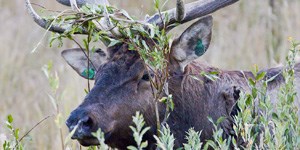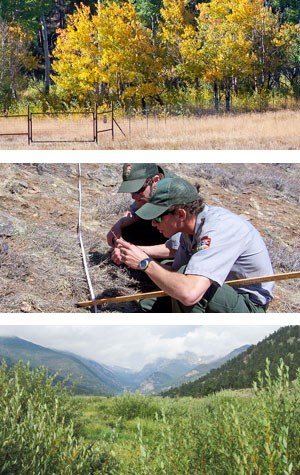|
Elk in Rocky Mountain National Park are part of a regional, migratory population. Elk and vegetation management in the park is guided by a 20-year plan that addresses the impacts of overabundant elk on park resources. The goal is to begin restoring the natural range of variability in the elk population and affected plant communities. 
NPS Research 1994-2006 Extensive research found that the elk population was larger, less migratory and more concentrated than it would be under more natural conditions. This resulted in heavy use of the winter range and a corresponding decline of vegetation habitats that many other wildlife species depend on. 
Middle: Park staff monitor vegetation conditions annually. Bottom: Willows are recovering in Horseshoe Park. NPS Interagency Plan Development 2003-2007 The Elk and Vegetation Management Plan/Environmental Impact Statement (EVMP)defines specific goals for the park's elk population and vegetation conditions. The plan presents a variety of conservation tools that include temporary fencing, vegetation restoration, elk redistribution and culling to achieve the following objectives:
This plan does not address chronic wasting disease management. If research suggests a need to manage the disease, it would be addressed by a separate disease management plan.
Implementation Phase 2008-2028
Park staff monitor progress toward achieving these objectives according to adaptive management principles outlined in the Elk and Vegetation Management Plan. Over time, park managers can then revise actions to successfully achieve these goals. Current research continues to advance our knowledge of these complex relationships through park supported scientific studies.
Current Conditions
The elk population is currently at or below the winter population objective of 600-800 animals on low elevation winter range. A report summarizing current elk population and vegetation conditions after five years of plan implementation will be released in 2015 as part of the first adaptive management review of plan implementation.
|
Last updated: September 22, 2025






